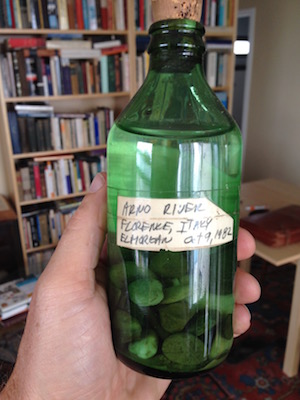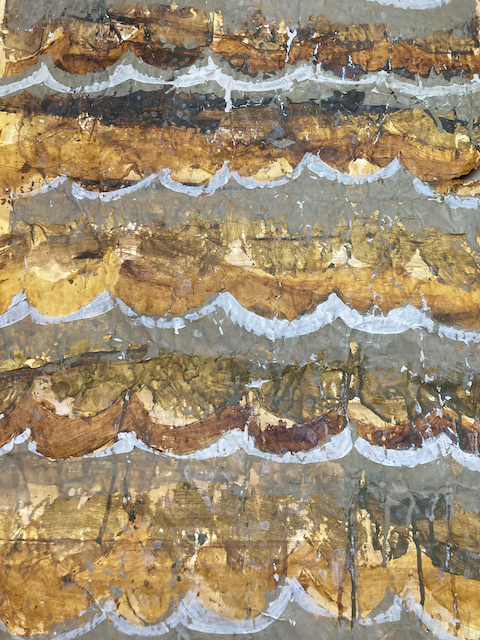As many of you may or may not know, I collect water, and it seems as if my water collection predicts the future, sort of.
 Since 1979 or so, I’ve been collecting water. [1] The purpose of the collection is/was enable me to see and experience different parts of the world whenever I desired. As the collection grew and my computer skills developed, I frequently used the water collection as a kind of Guinea pig for digital library projects. For example, my water collection was once manifested as a HyperCard Stack complete with the sound of running water in the background. For a while my water collection was maintained in a FileMaker database that generated sets of HTML. Quite a number of years ago I migrated everything to MySQL and embedded images of the water bottles in fields of the database. This particular implementation also exploited XML and XSLT to dynamically make the content available on the Web. (There was even some RDF output.) After that I included geographic coordinates into the database. This made it easy for me to create maps illustrating whence the water came. To date, there are about two hundred and fifty waters in my collection, but active collecting has subsided in the past few years.
Since 1979 or so, I’ve been collecting water. [1] The purpose of the collection is/was enable me to see and experience different parts of the world whenever I desired. As the collection grew and my computer skills developed, I frequently used the water collection as a kind of Guinea pig for digital library projects. For example, my water collection was once manifested as a HyperCard Stack complete with the sound of running water in the background. For a while my water collection was maintained in a FileMaker database that generated sets of HTML. Quite a number of years ago I migrated everything to MySQL and embedded images of the water bottles in fields of the database. This particular implementation also exploited XML and XSLT to dynamically make the content available on the Web. (There was even some RDF output.) After that I included geographic coordinates into the database. This made it easy for me to create maps illustrating whence the water came. To date, there are about two hundred and fifty waters in my collection, but active collecting has subsided in the past few years.
But alas, this past year I migrated my co-located host to a virtual machine. In the process I moved all of my Web-based applications — dating back more than two decades — to a newer version of the LAMP stack, and in the process I lost only a single application — my water collection. I still have all the data, but the library used to integrate XSLT into my web server (AxKit) simply would not work with Apache 2.0, and I have not had the time to re-implement a suitable replacement.
Concurrently, I have been negotiating a two-semester long leave-of-absence from my employer. The “leave” has been granted and commenced a few of weeks ago. The purpose of the leave is two-fold: 1) to develop my skills as a librarian, and 2) to broaden my experience as a person. The first part of my leave is to take a month-long vacation, and that vacation begins today. For the first week I will paint in Tuscany. For the second week I will drink coffee in Venice. During the third week I will give a keynote talk at ADLUG in Rome. [2] Finally, during the fourth week I will learn how to make croissants in Provence. After the vacation is over I will continue to teach “XML 101” to library school graduate students at San Jose State University. [3] I will also continue to work for the University of Notre Dame on a set of three text mining projects (EEBO, JSTOR, and HathiTrust). [4, 5, 6]
As I was getting ready for my “leave” I was rooting through my water collection, and I found four different waters, specifically from: 1) Florence, 2) Venice, 3) Rome, and 4) Nice. As I looked at the dates of when the water was collected, I realized I will be in those exact same four places, on those exact same four days, exactly thirty-three years after I originally collected them. My water collection predicted my future. My water collection is a sort of model of me and my professional career. My water collection has sent me a number of signs.
This “leave-of-absence” (which in not really a leave nor a sabbatical, but instead a temporary change to adjunct faculty status) is a whole lot like going to college for the first time. “Where in the world am I going? What in the world am I going to do? Who in the world will I meet?” It is both exciting and scary at once and at the same time. It is an opportunity I would be foolish to pass up, but it is not as easy as you might imagine. That said, I guess I am presently an artist- and librarian-at-large. I think I need new, albeit temporary, business cards to proclaim my new title(s).
Wish me luck, and “On my mark. Get set. Go!”
- blog postings describing my water collection – ./2009/09/water-1-of-3/
- ADLUG – http://www.adlug.net
- “XML 101” at SJSU – http://ischoolapps.sjsu.edu/facultypages/view.php?fac=morgane
- EEBO browser – https://github.com/ndlib/text-analysis-eebo
- JSTOR browser – https://github.com/ndlib/text-analysis-jstor
- HathiTrust browser – https://github.com/ndlib/text-analysis-htrc
 WordPress is a significant piece of software, and while its functionality is undeniable, maintaining the software in a constant process. It has become too expensive for me.
WordPress is a significant piece of software, and while its functionality is undeniable, maintaining the software in a constant process. It has become too expensive for me.
 Since 1979 or so,
Since 1979 or so, 